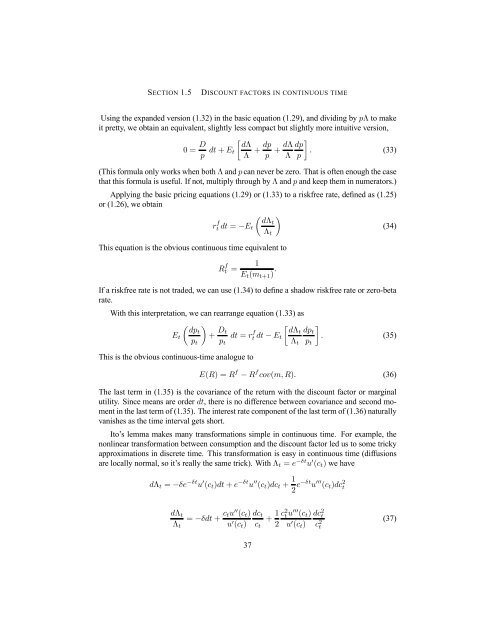Asset Pricing John H. Cochrane June 12, 2000
Asset Pricing John H. Cochrane June 12, 2000
Asset Pricing John H. Cochrane June 12, 2000
Create successful ePaper yourself
Turn your PDF publications into a flip-book with our unique Google optimized e-Paper software.
SECTION 1.5 DISCOUNT FACTORS IN CONTINUOUS TIME<br />
Using the expanded version (1.32) in the basic equation (1.29), and dividing by pΛ to make<br />
it pretty, we obtain an equivalent, slightly less compact but slightly more intuitive version,<br />
0= D<br />
· ¸<br />
dΛ dp dΛ dp<br />
dt + Et + + . (33)<br />
p Λ p Λ p<br />
(This formula only works when both Λ and p can never be zero. That is often enough the case<br />
that this formula is useful. If not, multiply through by Λ and p and keep them in numerators.)<br />
Applying the basic pricing equations (1.29) or (1.33) to a riskfree rate, defined as (1.25)<br />
or (1.26), we obtain<br />
r f<br />
µ <br />
dΛt<br />
t dt = −Et<br />
(34)<br />
This equation is the obvious continuous time equivalent to<br />
R f 1<br />
t =<br />
Et(mt+1) .<br />
If a riskfree rate is not traded, we can use (1.34) to define a shadow riskfree rate or zero-beta<br />
rate.<br />
With this interpretation, we can rearrange equation (1.33) as<br />
µ <br />
dpt<br />
Et +<br />
pt<br />
Dt<br />
dt = r<br />
pt<br />
f<br />
· ¸<br />
dΛt dpt<br />
t dt − Et . (35)<br />
Λt pt<br />
This is the obvious continuous-time analogue to<br />
Λt<br />
E(R) =R f − R f cov(m, R). (36)<br />
The last term in (1.35) is the covariance of the return with the discount factor or marginal<br />
utility. Since means are order dt, there is no difference between covariance and second moment<br />
in the last term of (1.35). The interest rate component of the last term of (1.36) naturally<br />
vanishes as the time interval gets short.<br />
Ito’s lemma makes many transformations simple in continuous time. For example, the<br />
nonlinear transformation between consumption and the discount factor led us to some tricky<br />
approximations in discrete time. This transformation is easy in continuous time (diffusions<br />
are locally normal, so it’s really the same trick). With Λt = e−δtu0 (ct) we have<br />
dΛt = −δe −δt u 0 (ct)dt + e −δt u 00 (ct)dct + 1<br />
2 e−δtu 000 (ct)dc 2 t<br />
dΛt<br />
Λt<br />
= −δdt + ctu00 (ct)<br />
u0 dct<br />
(ct) ct<br />
37<br />
+ 1<br />
2<br />
c2 t u000 (ct)<br />
u0 dc<br />
(ct)<br />
2 t<br />
c2 t<br />
(37)
















